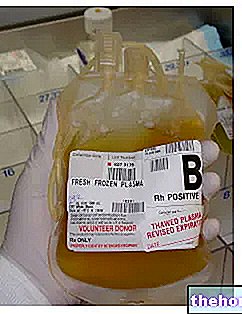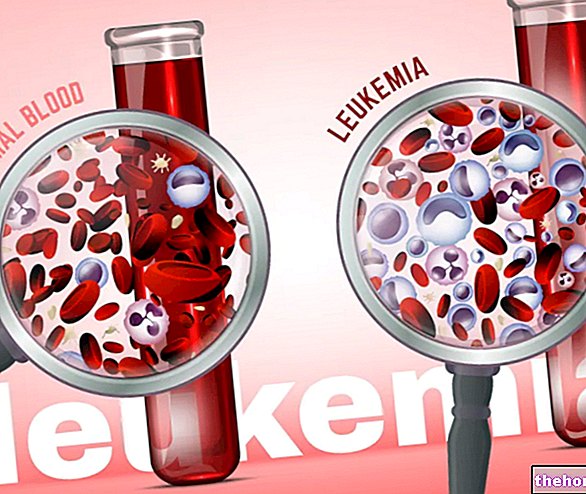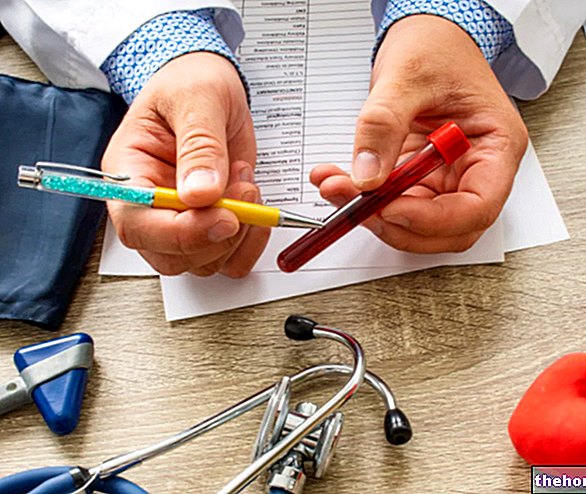Anemia is a disorder caused by the reduction of hemoglobin in the blood.
Hemoglobin is directly related to red blood cells, which in turn are an expression of the hematocrit (the corpuscular part of the blood). In case of anemia, the latter can undergo a negative variation confirming the diagnosis.

In severe cases: splenomegaly, related pains and slight hypothermia; a further clue is the fragility of the nails.
Anemia can be differentiated on the basis of etiopathogenesis. The forms that most depend on the diet are:
- Iron deficiency anemia: iron deficiency
- Pernicious anemia: deficiency of cobalamin (vitamin B12) and / or folic acid.
Due to menstrual losses, anemia is more common in fertile women than in pre-pubescent or menopausal women and in men.
Anemia can be triggered by inappropriate diets and worsened by certain particular conditions (extreme physical activity, etc.).
The material published is intended to allow quick access to advice, suggestions and general remedies that doctors and textbooks usually dispense for the treatment of Anemia; these indications must in no way replace the opinion of the treating physician or of other healthcare specialists in the field who are treating the patient.
What to do
Since anemia causes quite general symptoms, first you need to:
- Consult your doctor, who will prescribe a "complete blood test."
- Assess for blood loss or other forms of hematocrit depletion:
- Some pregnancies not obvious.
- Excessively abundant menstrual cycle.
- Motor activity that affects the integrity of red blood cells.
- Gastro-intestinal blood loss
In case of a positive diagnosis:
- Contact a dietician for a food history in order to verify the nutritional balance of the diet. The following must be evaluated:
- The total iron intake:
- The percentage of bioavailable iron:
- The best is the "emic" one.
- Non-emic iron is classified into:
- Ferrous (2+), poorly absorbed.
- Ferric (3+), almost totally NOT absorbed.
- The supply of vitamin C: necessary for the conversion of ferric iron into ferrous; it increases its bioavailability.
- The presence of other compounds that improve the absorption of ferric iron:
- Citric acid: typical of sour fruit such as lemon.
- Fructose: typical of fruit and vegetables.
- The presence of anti-nutritional factors:
- Excess of fiber.
- Excess of phytates.
- Excess of oxalates.
- Excess of tannins.
- Excess of ethyl alcohol.
- The supply of vitamin B12 (cobalamin): necessary for erythropoiesis.
- The supply of folic acid: also necessary for erythropoiesis.
- If the cause is of a food type, the dietician will (as far as possible) correct the nutritional scheme in accordance with personal needs (veganism, vegetarianism, Hindu religion, Buddhist, etc.).
- If the anemia does not heal, it becomes necessary to go back to the doctor and look for other responsible causes such as:
- Thalassemia.
- Hereditary diseases.
- Hepatic or renal insufficiency.
- Gastric complications:
- A deficiency of hydrochloric acid (hypochlorhydria) inhibits the intestinal absorption of iron.
- A deficiency of intrinsic factor inhibits the intestinal absorption of vitamin B12.
- Intestinal complications, especially of the terminal ileus where vitamin B12 is absorbed.
- Other pathologies that can compromise absorption such as:
- Celiac disease or celiac disease.
- Tropical sprue: occurs during trips abroad. It is probably due to food poisoning and infestations.
- Inflammatory bowel diseases (Crohn's disease, Ulcerative Rectum-Colitis): sometimes, they are also responsible for the surgical resection of a part of the intestine.
- Other pathologies that can aggravate the symptoms of anemia (low blood pressure, hypoglycemia, etc.).
What NOT to do
In case of anemia it is not recommended:
- Ignore the doctor's recommendations.
- Practicing intense and prolonged motor activity (if the anemia is not compensated).
- Follow low-calorie or unbalanced diets.
- Indulge in alcoholism.
- Ignore the dietitian's recommendations.
- Ignoring diagnoses of diseases that can cause or worsen anemia and / or its symptoms.
- Ignore pregnancy, even if it is in the prospect of abortion and in the very first few weeks.
What to eat
The anti-anemia diet is quite complex as several nutrients and food groups are involved. Below we will list the most important dietary recommendations:
- To ensure the intake of iron, especially heme and ferrous (2+), it is necessary to eat:
- Muscle tissue: both of terrestrial and aquatic animals: horse, bovine, swine, avian, fish, whole molluscs (including land snails), whole crustaceans, etc.
- Eggs: any, especially the yolk.
- Offal and fifth quarter: especially spleen and liver, but also marrow, diaphragm, heart, etc.
- To ensure the supply of vitamin C, citric acid and fructose, it is necessary to eat:
- Sweet and sour fruit: lemon, grapefruit, orange, mandarin, kiwi, cherries, strawberries etc.
- Vegetables and tubers: parsley, pepper, lettuce, spinach, radicchio, broccoli, tomato, potato, etc.
- To ensure the supply of vitamin B12 (cobalamin) it is necessary to eat:
- The same foods as a source of heme iron
- To ensure the supply of folic acid it is necessary to eat: liver, vegetables (eg tomatoes), sweet fruit (orange, apple, etc.) and legumes (eg beans).
NB. Folic acid is also a thermolabile molecule and degrades with cooking. This means that to ensure its intake it is advisable to eat specific foods in raw form.
NB. Vitamin C or ascorbic acid is a thermolabile molecule and degrades with cooking. This means that to ensure its intake it becomes necessary to consume many raw foods. Furthermore, being involved in the absorption of the little available iron, it is important that it is taken with specific foods.
Remember that certain foods may contain anti-nutritional principles that reduce the absorption of iron. To reduce its content, it is necessary to practice:
- Soaking.
- Fermentation (yeasts or bacteria).
- Cooking.
NB. Since cooking inhibits nutritional principles but limits the availability of thermolabile vitamins, it is advisable that raw and cooked foods are equally present in the diet.
It is advisable to reserve the heat treatment especially for legumes and cereals, while most of the fruits and vegetables could be eaten raw.
What NOT to Eat
The foods not to eat in case of anemia are those that lose certain nutrients or that contain too many anti-nutritional principles:
- Foods deprived of important molecules: cooked and / or preserved vegetables, fruits, potatoes and legumes. They tend to drastically reduce the concentration of vitamin C or ascorbic acid and folic acid.
- Foods that contain too many anti-nutritional ingredients:
- Dietary fibers: they are essential for intestinal health but in quantities of about 30g / day. In excess (especially over 40g / day) they can trigger a laxative effect, produce liquid stools and expel most of the nutrients taken with the diet; among these also iron.
- Phytic acid and phytates: they tend to chelate iron preventing intestinal absorption. They are very abundant: in the peel of legumes, in the peel of cereals (bran) and in certain oil seeds (eg in sesame).
- Oxalic acid and oxalates: like the previous ones, they tend to bind iron, hindering its intestinal absorption. They are rich in it: the husk of cereals, spinach, rhubarb, etc.
- Tannins: also endowed with chelating power, although they are also antioxidants, they can hinder the uptake of iron. They are present: in wine, tea, fruit seeds (eg grapes, pomegranates, etc.), persimmons and in unripe bananas, cocoa, etc.
- Calcium: it is essential for the body but, in the intestine, it conflicts with the absorption of iron. Foods rich in iron and calcium should be taken in different meals. Those that abound in calcium are mainly milk and derivatives.
- Alcohol: ethyl alcohol is an anti-nutritional molecule and hinders the absorption of all nutrients, including iron, vitamin C, folic acid and cobalamin.
Natural Cures and Remedies
Natural remedies for anemia are few and are limited to the intake of food supplements with single or combined molecules:
- Iron.
- C vitamin.
- Folic acid.
- Cobalamine.
A natural remedy against anemia very popular in the Middle Ages was solid iron (today the practice is not recommended):
- Spiked apple: the apple is enriched with iron thanks to the reaction between it and food acids. It is produced by driving the nails into apples and removing them after a day or two, before consuming the fruit.
We also remember that:
- It is not always recommended to take natural herbal teas; regardless of their presumed function, many of them provide certain anti-nutritional molecules that we have already talked about.
Pharmacological treatment
Orally, intramuscularly or intravenously they can cure both iron deficiency and pernicious anemia.
The most common treatments against iron deficiency anemia are:
- Ferrous salts: taken orally, in some cases they give rise to side effects such as heartburn, abdominal cramps, constipation or diarrhea.
- Ferrous sulphate (eg Ferrograd): is the elite product for the treatment of pernicious anemia. It is effective and has few side effects.
- Iron dextran: injectable.
- Iron fumarate (eg Organic Iron): available in solution to be taken orally.
- Iron gluconate (e.g. Sidervim, Cromatonferro, Bioferal, Losferron): available in effervescent tablets.
- Carbonyl iron (e.g. Icar): available orally.
- Iron saccharate (e.g. Ferrum Hausmann Orale, Venofer): available for oral use.
- Hematopoietic growth factors: they are useful when iron deficiency anemia depends on renal insufficiency or neoplasms.
Against pernicious anemia, folic acid and cobalamin-based injections are mainly used.
Prevention
The prevention of anemia is exclusively of the food type.
It is advisable:
- Follow a varied but specific diet:
- With foods rich in heme iron and cobalamin:
- About two portions of meat per week (150g l "one).
- About two portions of fishery products per week (150-200g l "one).
- About two to three eggs per week.
- About three or four portions of dried legumes and the same number of whole grains, soaked or fermented and well cooked per week (from 80g l "one).
- With foods rich in vitamin C, citric acid and folic acid:
- Two servings a day of fresh, medium-sweet raw fruit (100-200g l "one).
- Two servings a day of fresh raw vegetables (100-200g l "one).
- Avoid combining foods containing heme iron with foods containing excessive amounts of: phytic acid and phytates, oxalic acid and oxalates, tannins, calcium, ethyl alcohol and dietary fiber.
If one of the causes of anemia is recognized "excessively prolonged and intense aerobic physical activity (for example endurance running), it is necessary to:
- Reduce activity or try to improve diet / supplementation.
Medical Treatments
In addition to diet, supplements and medications, some more challenging remedies can be useful for severe anemia, such as:
- Blood transfusions: in particularly severe cases it is possible to proceed with a blood transfusion.
- Oral contraceptives: in case of particularly heavy menstruation the risk of iron deficiency anemia increases considerably, given the large amount of blood lost due to hypermenorrhea. By regulating menstrual flow, oral contraceptives could represent a possible therapeutic option.
- Any surgical interventions to resolve bleeding (eg for varicose veins of the digestive tract, gastric ulcer, etc.) or bleeding polyps: they are responsible for the occult or visible loss of blood in the stool and consequent anemia.






-cosa-significa-quando-preoccuparsi.jpg)





















